People
‘Approach Every Black Artist as a World-Maker’: Art Historian Bridget R. Cooks on the Need for an Expansive Definition of Blackness
Cooks is the award-winning author of "Exhibiting Blackness."
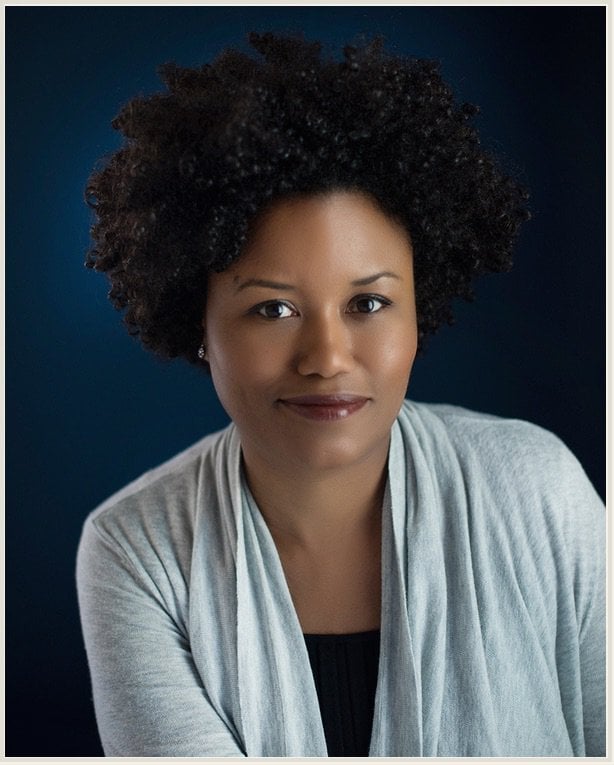
Cooks is the award-winning author of "Exhibiting Blackness."

Folasade Ologundudu

This article is part of a series of conversations with scholars engaged with Black art for Black History Month. See also Folasade Ologundudu’s interviews with Richard J. Powell, Darby English, and Sarah Lewis.
***
Bridget R. Cooks first made a splash by casting a critical eye on museums.
In her much-discussed 2011 book, Exhibiting Blackness: African Americans and the American Art Museum, Cooks looked at the ways that museums have perpetuated racial inequity through the presentation and curation of African American and African diaspora artists. Her account started with the very first show in America featuring African American artists, at the Art Institute of Chicago in 1927, and continued into the 21st century with the reception of figures including the Gee’s Bend quilters. Exhibiting Blackness was awarded the inaugural James A. Porter & David C. Driskell Book Award in African American art history in 2013.
Bridget R. Cooks received her doctorate degree in Visual and Cultural Studies Program at the University of Rochester. Today, she is an associate professor of Art History and African American Studies at the University of California. Her most recent project, sponsored by a grant from the Ford Foundation, is “The Black Index,” a show and accompanying book spotlighting artworks which “build upon the tradition of Black self-representation as an antidote to colonialist images,” on view online and at UC Irvine’s Contemporary Art Center.
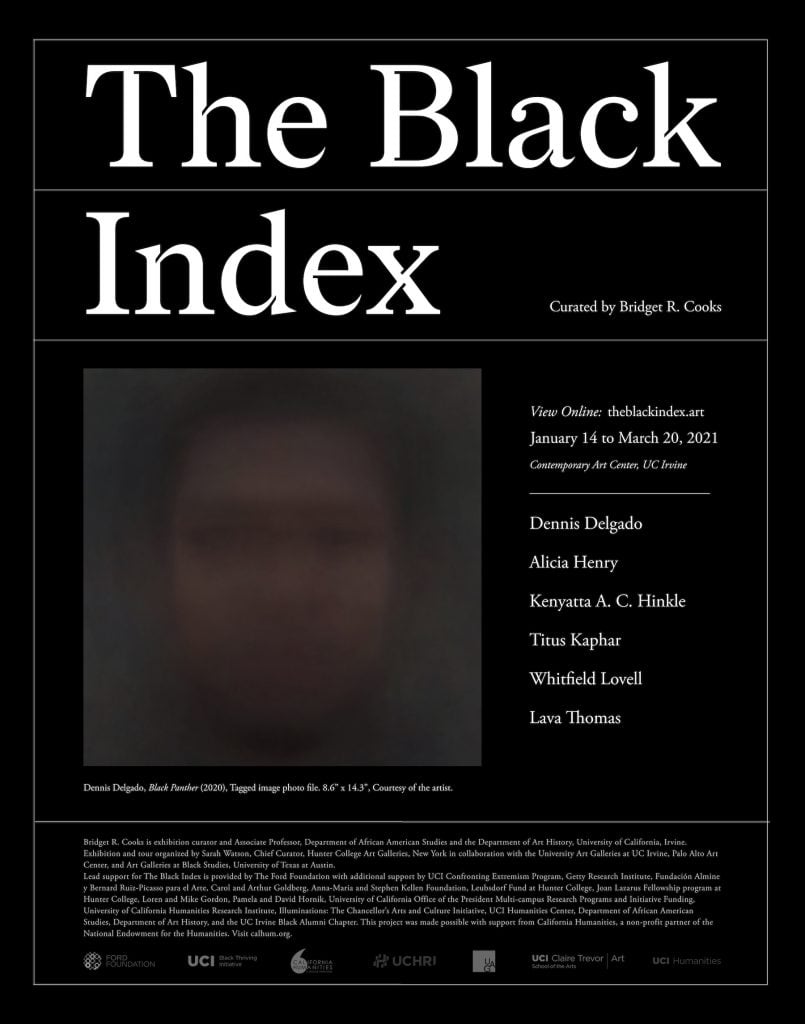
A poster for “The Black Index.”
In a recent interview, Cooks revealed why thoughtful criticism is required to understand African American art and art history, how advocates in the field opened doors for her early in her own career, and why structural change in museums can bring more equity to the world of African diaspora art and artists.
What inspired you to pursue a career in academia? And are there certain moments that propelled you to take a deeper interest in the study of African American art history?
I had no plans to be an academic. I wanted to work in museums in college. I was an art history major but I realized I wasn’t learning anything about Black artists and this was an area that needed development that I could contribute to, so I went to graduate school.
I found that every book that I wanted to read was written by [photography scholar] Deborah Willis and I was able to connect with her. She gave me an internship opportunity working at what’s now the National Museum of African American History and Culture. I worked with someone I really respected who did incredible research and who became a mentor for me.
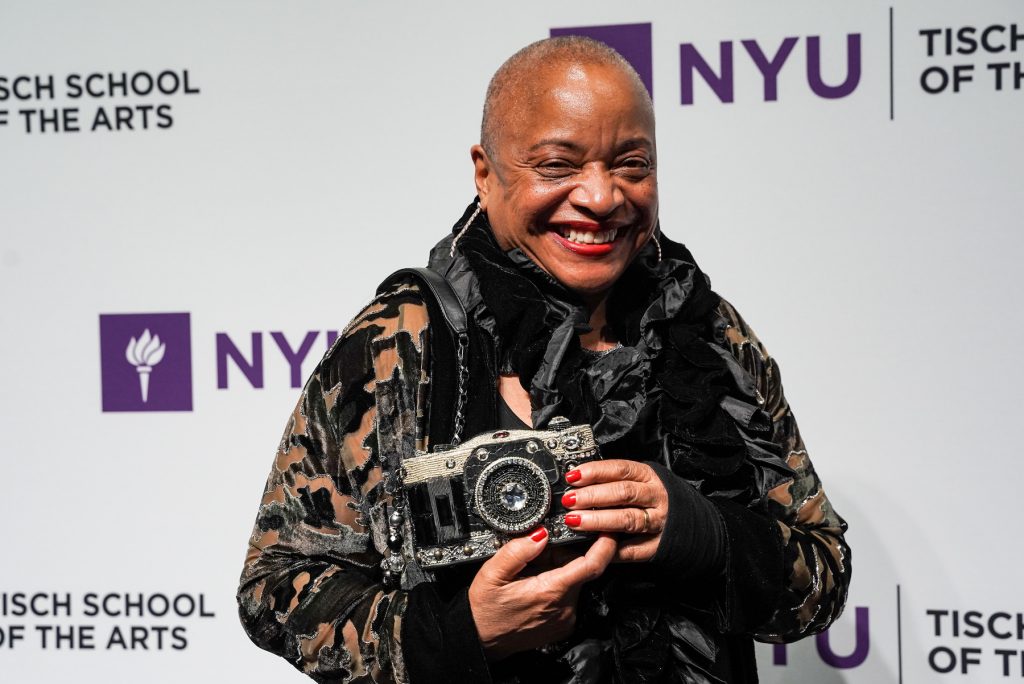
Deborah Willis attends the NYU Tisch Gala 2019 at St. Ann’s Warehouse on April 8, 2019 in New York City. (Photo by Sean Zanni/Patrick McMullan via Getty Images)
I worked in museums for years and realized that in order to do the research and writing I wanted to do, I’d need to be an academic. Working at a university allowed me more flexibility and freedom to teach and gave me time to research and write about Black artists.
African American art history looks to authors, artists, and curators such as Alain Locke, Romare Bearden, and David Driskell. Can you elaborate on some of the ways these figures changed the face of African American art history as we know it today?
All of those people have been very influential in establishing that the long creative tradition of African American people needs to be recognized, understood, displayed, respected, and included.
Alain Locke was a philosopher at Howard University and he played an important role in defining the arts during the Harlem Renaissance. He was very effective in getting white funding for Black artists. He appreciated what Black artists were doing using Black creativity as a way to make social change, which is something that is still a core value for many Black artists today. But he also knew how to engender the kind of empathy or interest from wealthy white people to help, giving the opportunities for exhibitions and funding for travel—notably through the Harmon Foundation—to develop themselves as artists.
Romare Bearden co-authored A History of African-American Artists with Harry Henderson. The book is almost like an encyclopedia of works by Black artists, a kind of reference point.
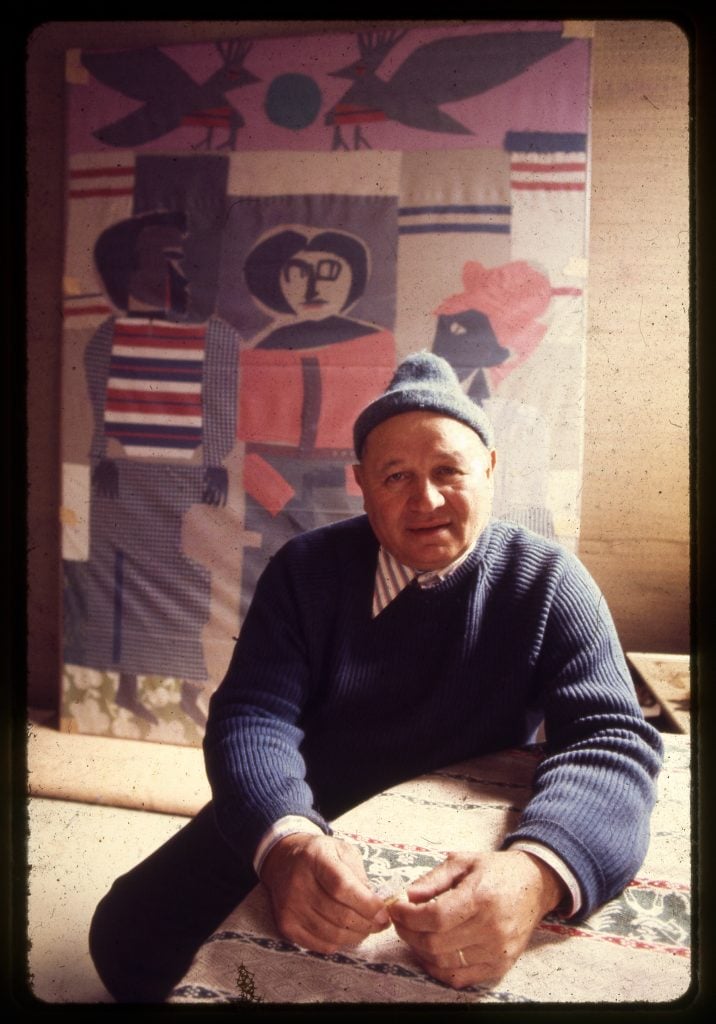
Portrait of artist Romare Bearden, New York, 1972. (Photo by Anthony Barboza/Getty Images)
These are people who are doing more than one thing: they are artists, curators, institution builders. They’re also activists and that’s something Black artists have always had to be. You’re making the work, but also educating people and fighting for a space for you to be able to express yourself in a way that shows you as contributing to the field.
Right. And shows you as valuable.
Exactly, because no one else is going to do it for us. We have to do it for ourselves. It is just us.
![<em>Chicago Defender</em> publisher John H Sengstacke [right] stands next to professor David Driskell of Fisk University as they attend the "Black Esthetics" show held at the Museum of Science and Industry, Chicago, 1974. (Photo by Robert Abbott Sengstacke/Getty Images)](https://news.artnet.com/app/news-upload/2021/02/david-driskell-john-h-sengstacke-1024x627.jpg)
Chicago Defender publisher John H Sengstacke [left] stands next to professor David Driskell of Fisk University as they attend the “Black Esthetics” show held at the Museum of Science and Industry, Chicago, 1974. (Photo by Robert Abbott Sengstacke/Getty Images)
Absolutely. Because they’re pioneering how you will think about the study of the field; how you will be a gatekeeper for the next generation—and not a gatekeeper in the sense of closing doors, but of keeping doors open.
Exactly. And really feeling like there’s room for everyone, right? Because everyone has a vision. Everyone has a contribution to make, everyone has a different talent.
Another thing I’d say I got from all of those people—and I need to add Deborah Willis to that—is you need to come correct. Do your research, take this seriously and bring your best. That’s something that all of them have modeled for thousands of people.
Unlike other forms of art history, African American art history doesn’t have generations of thought and criticism published to disseminate the work and contributions of African American and African diaspora artists. How does this lack of criticism affect one’s ability to understand African American art? Who, if anyone, is responsible for closing the gap?
We only have a couple of generations of art historians compared to other fields like Renaissance art history. This is a field that’s just barely emerging. We don’t have enough good criticism of the art and part of that is because the work of African American artists has not been considered seriously by art critics.
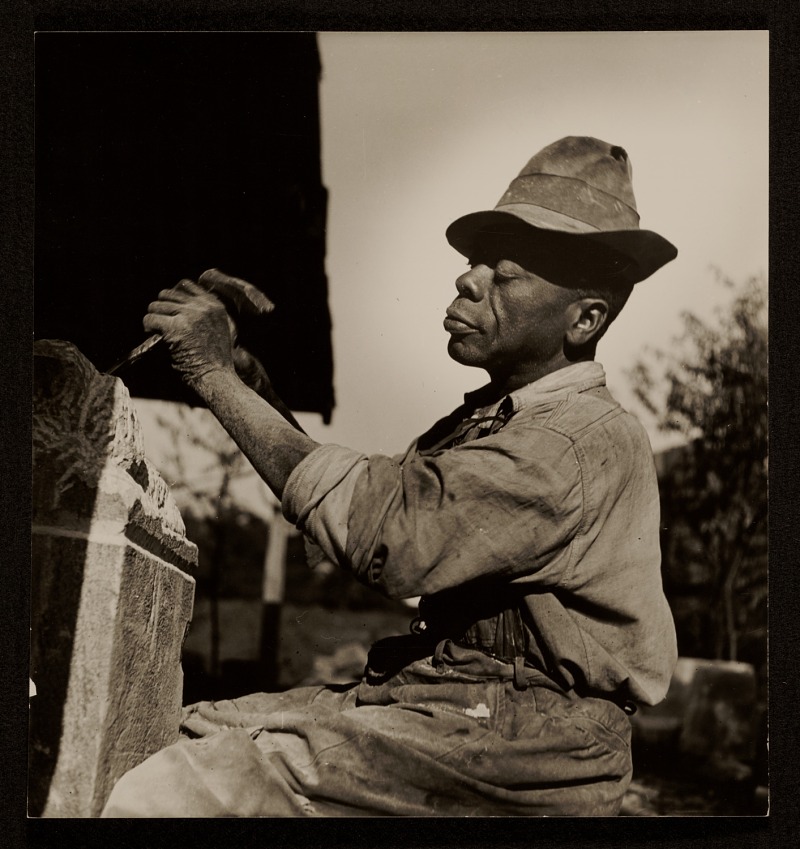
Louise Dahl-Wolfe, Portrait of William Edmondson (1937).
When African Americans like William Edmondson or Palmer Hayden had art exhibitions, if it was reviewed in the paper, it was in the general interest category with a headline that said something like “Janitor Who Paints Has Exhibition” or “Negro Art at the Museum of Modern Art.” It wasn’t in the section where serious artists were recognized as making a contribution to contemporary art.
We need more critics who’ll take the work seriously, who can expand ideas of what Blackness is. We need people who are engaged in the social context in which we live today, who can appreciate figuration as well as abstraction. So many critics see that the artist is Black and it limits the way they understand and critique possible interpretations of the work. So we need people who are against anti-Blackness and can see a full complexity of Black people and the art that we make.
Black art is most often understood in terms of its Blackness with the near complete abandonment of its existence outside of race. Why is this a problem? And how can this supposition of race as paramount be remedied through academics and scholars who think critically about the work outside the confines of race, race relations, and the inequities of Black life in America and abroad?
For me, the root issue is, what is a person’s definition of Black? The issue I’m having right now is that you can say “Black art,” I can say “Black art,” and we might have two very different understandings of what we’re referring to.
For some people, when they say “Black art,” the art must be figurative, it must be angry. But for Black people, we know that being Black is not equal to having a limited understanding of the world. Blackness is everything. It is everywhere, right? We are the foundations of modernism. The world is organized around our labor and our natural resources—human resources included. So we see Blackness everywhere and the whole structure of the world is in negotiation with our existence.
So my understanding of Blackness is quite wide and expansive. When I come to work made by a Black artist, I don’t suddenly shut down my parameters or close the gates of interpretation. Until people can understand the expansiveness of Blackness, they’re not going to understand the richness and complexities of art by Black artists.
How can newer, more expansive, and elaborate interpretations of Blackness be redefined through the study of African American art and history in the future?
I would say that one should approach every Black artist as a world maker. Artists are visionaries. Artists see things in a way that no one else can. They create worlds within their works and one of the privileges of doing studio visits or hearing artists speak about their work or being in conversation about their work is the joy of seeing things through their eyes.
If you’re looking at the work of five Black artists, the deeper you look, the more you will see how diverse this group is. Expand your idea of what you thought Blackness was and what the limits of Blackness were in your mind.
In 1971, artists protested the Whitney’s “Contemporary Black Artists in America” show curated by Richard Doty—a white curator—calling the show racist in its refusal to include or consult African American artists and/or scholars in the curatorial process. Last year, nearly 50 years later, the Whitney canceled its exhibition, “Collective Actions: Artist Interventions in a Time of Change,” as heavy backlash mounted against the museum’s purchase of work by Black photographers via See in Black at a highly discounted price for a fundraiser in response to Black Lives Matter. In your opinion, are museums still operating in a colonial mindset? How does this have adverse effects on our understanding of the value of African American art, culture, and history?
Museums like to be in the position of power. They even have authoritative colonial architecture in many cases: think about the Philadelphia Museum of Art, the Metropolitan Museum of Art—this neoclassical design that establishes their presence as timeless, as true, as objective and authoritative. Museums benefit from projecting an image to the world that they’re the best receptacles of history, truth, and memory.
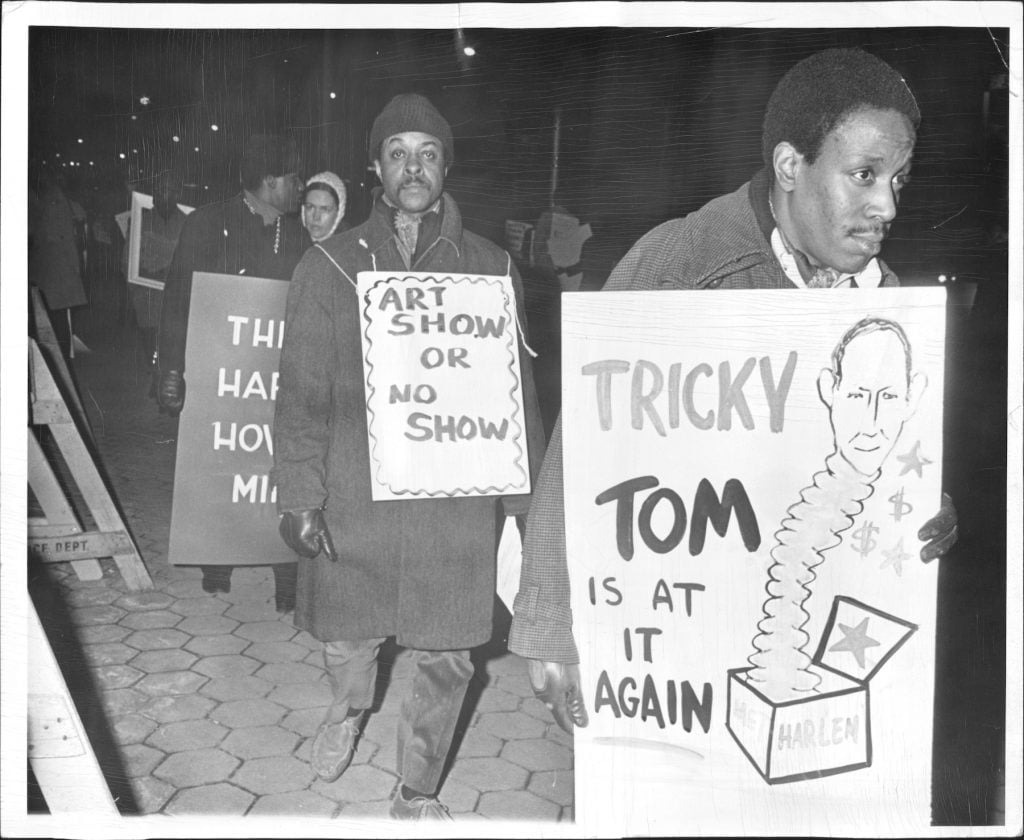
Demonstrators protest the “Harlem on My Mind” exhibit at the Metropolitan Museum of Art, January 17, 1969. (Photo by Vernon Shibla/New York Post Archives/© NYP Holdings, Inc. via Getty Images)
In 1971, partly in response to the fiasco of the “Harlem on My Mind” exhibition at the Met in 1969, the museum said, “we’re going to have this show and we’re going to include Black artists.” But the Black Emergency Cultural Coalition (BECC), which was the main organization protesting the show, said that wasn’t enough. The artists who were protesting the exhibition wanted transformative structural change. The museum was not interested in that because that would mean they’d have to hire Black people to curate, to educate, to be in positions of influence and power. When museums get called out for colonial behavior—which is the foundation of museums: colonial collections in public museums—they’re doing this sort of band-aid approach for publicity’s sake. They’re not interested in rethinking our history or the function of the museum.
What happened with the Whitney recently is very different, but I think the message is largely the same. There’s not enough structural change. There’s not a sense that when you organize an exhibition of work by Black artists, you actually need to meet them, make studio visits, figure out who they are. You need to know what they think about their work and how they would like the work to be understood.
What’s complicating this a little bit is the fact that some museums have hired Black curators recently and the Whitney Museum is an example of this. The Whitney biennial was co-curated by Rujeko Hockley—so there are some changes. But one Black person or two or even three Black people is not necessarily an indication of structural change. It is an indication of a gesture towards diversity. That is not the same as structural change. It’s not the same as understanding the history and current perpetuation of a colonial presentation of art history in the museum.
So showing Black people at a discount and getting credit for looking diverse with BLM protesters, that’s not the answer. It really just showed that the museum wasn’t deeply invested in building relationships with these Black photographers.
Black Lives Matter has opened up a huge conversation about representation. What opportunities do you see for the field of art history and black art historians? Are there pitfalls too?
BLM has opened up the conversation for empowering Black people who have worked inside museums in the past, who work there now, and who’ve been unhappy with the way they’ve been treated in museums as visitors. For many museums, Black Lives Matter is trending. It’s popular. The marketing department says, “okay, let’s do something without any recognition of what the words mean: Black Lives Matter.”
Museums have felt a pressure to respond and have no idea what responding would mean. They also seem to have no idea about their own past relationships with Black staff. It’s really shown that people who have been museum directors and high in administration are completely unaware of the culture of racism.
My fear is that diversity departments are going to emerge as a kind of silencing gesture to say, “look, we have this department that says you need to be diverse.” That’s not going to change anything unless there’s real activism going on in a museum. There has to be a shift of authority and power and that’s something that museums don’t want to give up.
BLM has pressured people who work at museums to deal with how Black Lives Matter and institutions and museums are largely sorely ill-equipped to even address the question of Black lives mattering. There has to be work done in order for that to be true and museums have to now really be accountable if they’re going to claim that Black Lives Matter for them.
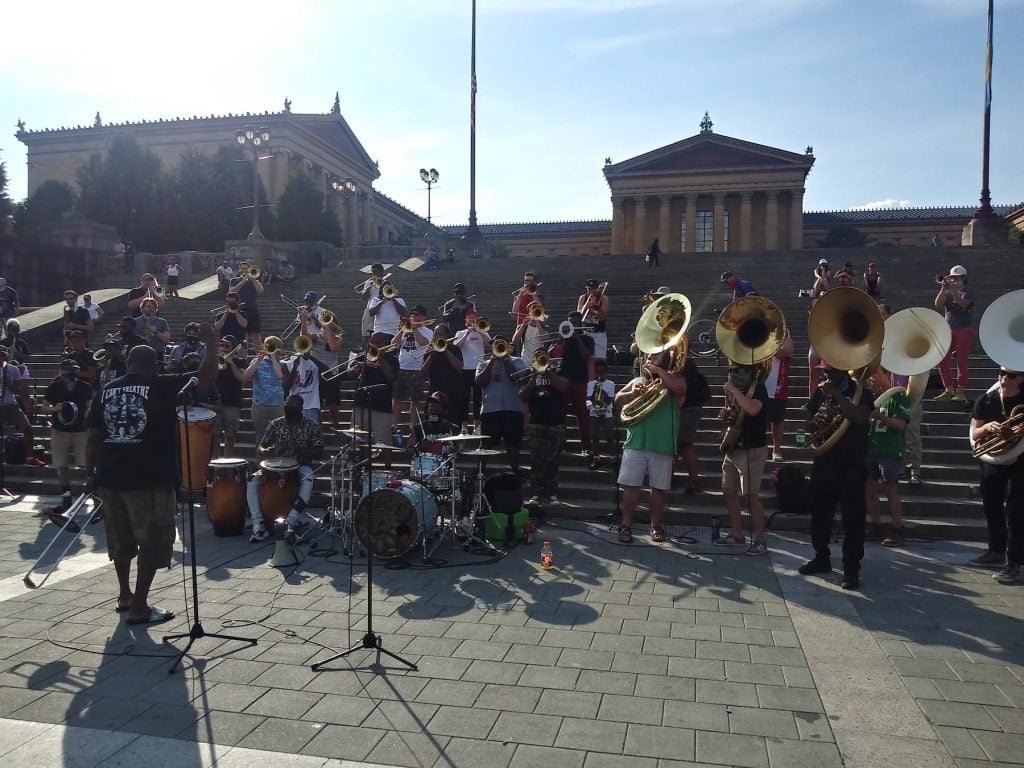
The Brotherhood, a Philadelphia band, performs in front of the Philadelphia Art Museum in support of the Black Lives Matter movement on July 5, 2020. (Photo by Cory Clark/NurPhoto via Getty Images)
I wanted to dig a little bit deeper into that and talk about the moment that we’re living through in terms of this performative allyship—but also in terms of how we could actually see the change we want to see happen and take place at a more institutional level. What’s your opinion about all of that?
Museums exist based on a funding structure that they have figured out. They get a certain amount of municipal funds, but most of their money comes from private donations. American wealth as a capitalist country is based on exploitation. That’s how capitalism works. Many people who are wealthy are not interested in ideas such as Black Lives Matter because it’s antithetical to the way that they make money.
So museums don’t have to change. If they want to change they’re going to have to be uncomfortable. They’re going to have to face realities that are going to mean structural transformation.
I think for many museums Black Lives Matter is a PR issue. It’s about image—but in reality Black Lives Matter is about structural transformation. You’ll see many museums on their websites when you open a webpage there’s a Black man and a Black woman or a Black child. We recognize when we’re being used as a poster for diversity; we’re not fooled by the surface.
The folks in the BECC in 1971 weren’t either. They were saying, “yeah, you can show our work—but what are the things that are happening inside the museum?” When the show is over, how is there going to be lasting change at institutions? Museums by and large have not figured out that question because it’s just not an important question for them.

Cover of Exhibiting Blackness: African Americans and the American Art Museum by Bridget R. Cooks (University of Massachusetts Press, 2011).
Right. But it’s such an important question for where we are as a society.
Yes, absolutely.
The interesting thing is that if a museum exists to teach us about culture and about where society is, where it’s been, where it is in the present, and where it can go in the future, I say to myself, why aren’t museums taking a larger role in shaking up the status quo and doing things differently?
They have so, so many opportunities to do things differently. They have an incredible platform. They have incredible resources. Even if they just re-install their permanent collections, which means not spending very much money at all, they can show the recommitment or new commitment to change. It’s not something that you have to necessarily put millions and millions of dollars into.
But I think they should hire people who can be consultants, who are Black people, who can come in and speak honestly to them about what the demands are and what being relevant actually looks like. And those people should be paid for that work. The problem is museums have been closed and exclusive, and now is the time to open up and listen and pay people for the work they’ll do to help museums change.